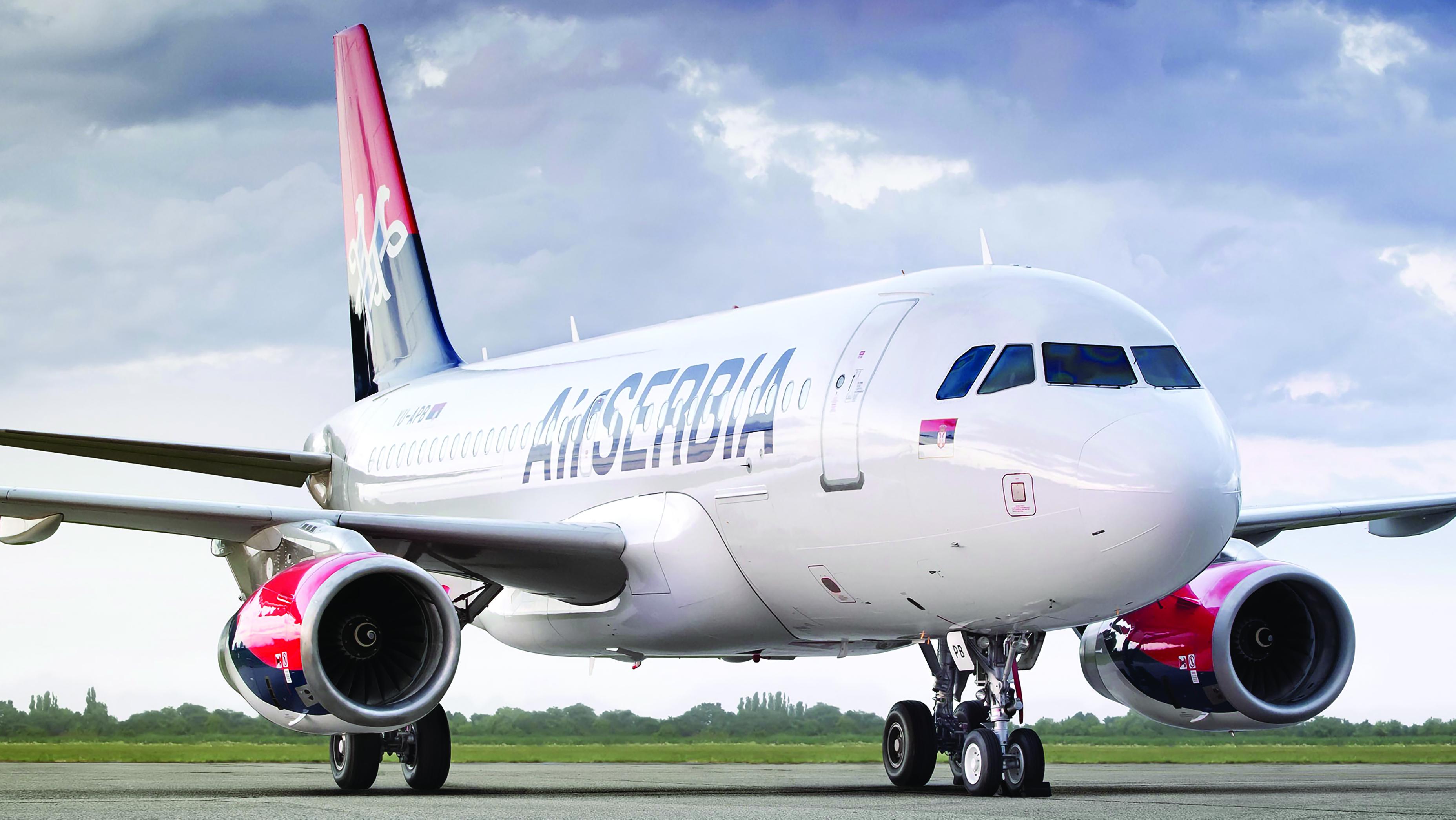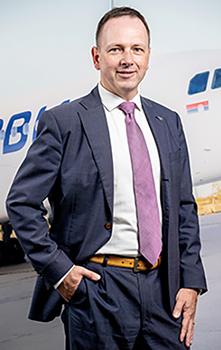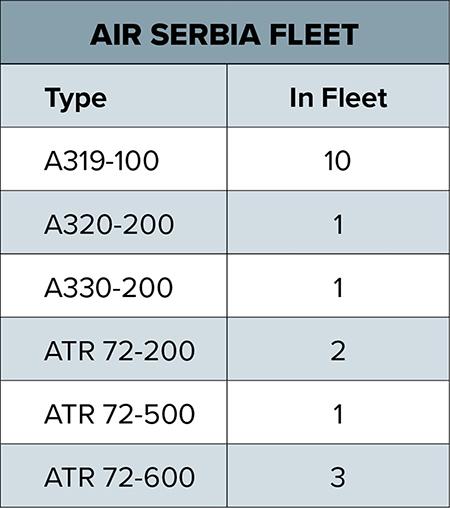
Jiri Marek was promoted to CEO at Air Serbia in January, having been with the airline since July 2019 when he led the company’s commercial and strategy department. The Belgrade-based airline is 82% owned by the Serbian government and 18% owned by Abu Dhabi-based Etihad Airways. Marek is looking at growth opportunities in China and the US as well as within Europe, and has set fleet renewal plans in motion to support those ambitions.
–Interview by Kurt Hofmann
Air Serbia is adding a second Airbus A330-200 to its fleet and may take a third. How will you use those widebodies? Having a second widebody aircraft is a big deal for a regional airline of our size. We will launch one weekly service to Tianjin in China from October this year and twice-weekly service from Belgrade to Chicago O’Hare from April 2023. We also plan to increase frequencies to New York JFK during the winter season to three times weekly, instead of two. Our New York operation, which has six-times-weekly service in the summer, is profitable and, combined with the new opportunities in China and an expansion in the US, it was the next logical decision to go for a second aircraft. However, our plans don’t stop there and once COVID restrictions are lifted in China, we see there an opportunity for a potential third A330-200 and for further growth in China.

Where are you looking to expand in China? We are satisfied with the performance of our A330-200, but flying just to one long-haul destination with just one aircraft is quite challenging. Our growth plans include flights to Beijing and Shanghai, once COVID restrictions in China have been lifted and such operations are allowed. A lot of traffic flow between China and Europe is currently limited, and some routes remain complicated regarding closed air spaces over certain geographies [because of the Russia-Ukraine war]. The geographical position of Belgrade, however, opens new opportunities and route alternatives to Asia. We are ready to explore them.
Do you also need to add more European destinations? These things are not dealt with in isolation. We are currently planning around a dozen new destinations for next year, as well as more frequencies in the region to guarantee connectivity to Chicago, New York and China. And this is also the reason why we started the ATR 72 fleet renewal process, especially as we can capitalize on the current favorable market conditions concerning aircraft procurement. Two more ATR 72-600s are joining the fleet in November and December and three more are on the shortlist for next year. The majority will be to replace older ATRs, but we are also evaluating cargo conversions with those older ATRs. We are finalizing the business case for which routes from Belgrade could be utilized by such cargo aircraft. An optimal fleet size of ATRs for us is a minimum of 10 aircraft. Then you can capitalize on some economies of scale. In 2023, we plan to operate seven to eight ATRs, while our ambition is to go beyond 10. Our fleet will continue to grow in the years to come and it is a logical choice to grow organically and above with the market.
You have one A320 and 10 A319s that are older. Are you looking to replace those aircraft? The market continues to mature, and our region [the Balkans] is forecast to grow 5-8% a year. Before COVID, our fleet of ATRs and A319s was a perfect fit for Air Serbia’s business model. For any fleet expansion or replacement, Air Serbia is targeting those aircraft that are up to 12 years old, which represent good value for the money. Since Airbus is not developing the A319 program, the Air Serbia fleet will naturally be upgraded with A320s. Capacity differences between the ATR and A320 might open the door to introduce some regional jets in the near future. However, this is at an initial stage of discussion. I also don’t rule out the A320neo because there are also favorable conditions in the market for that aircraft. However, an oversupply of secondhand A320ceos is being seen in the market and lessor activity reflects that. Our overall ambition is to grow yearly by a minimum of one jet and one or two ATRs.

There is a lot of construction work going on at Belgrade Airport, which is Air Serbia’s hub. How will this affect your operations related to transfer passengers? As you increase the capacity, you naturally increase the volume of transfer as well. However, we would like to keep a healthy share of 30-35% transfer passengers. Our core baseload to cover operational costs will remain within the point-to-point segment and transfer would be as additional income on top. But the share of transfer traffic will be different in summer and winter. We aim to be the leading airline in our region. Hence, we will continue to grow with the market to maintain our market share in Belgrade over 50%, and leverage our position to attract new and further develop existing codeshare partnerships. We are thankful that the airport is investing heavily, and they did not stop investing and working during COVID. The new terminal is planned to open before summer 2023 and we are paying attention to our own product and how it adjusts with the new infrastructure. For example, we will be able to have a separate business class check-in area, similar to a hotel lobby, of the type you see in the Middle East or Asia. In 2019, the airport had 6 million passengers; in the future this will grow to have capacity for 15 million passengers.
There are several small airlines in the Balkans. Do you see industry consolidation happening? In general, Belgrade will always be the center of gravity for this region. It is natural to capitalize on the advantages of this city as our hub. Consolidation could come one day, but in general in Europe, loyalty to the brand of a local airline is quite strong and consolidation is not happening at the same speed as observed in other regions in the world. Consolidation in this region would make sense commercially and we would be a natural platform for this process, but is it realistic in the near future? I don’t think so. Whenever there is an opportunity in the region, we are the first to grab it. When Slovenia’s Adria Airways collapsed, we were the first to capitalize on it. The new wave of opportunities will be enabled once the Open Skies agreement is fully implemented within the western Balkans and we will consider all those new opportunities. However, our main hub will remain in Belgrade.
You have 18 aircraft and 1,100 employees; is that the right ratio? There is always room to improve efficiency. We are looking at the best practices in the industry and quite often we benchmark our KPIs against airlines like Aegean Airlines and airBaltic. Capacity growth will always be faster than manpower, further improving our competitiveness. We are aware that we cannot become an LCC, but we would like to position our costs so they are below our legacy carrier peers, while providing a superior product at a bit of premium price. Some call that a hybrid airline model. However, it’s really a logical response to the current market environment.





